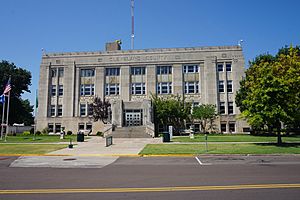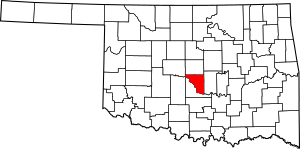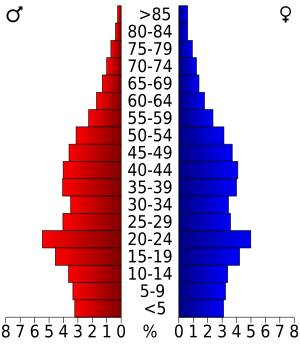Cleveland County, Oklahoma facts for kids
Quick facts for kids
Cleveland County
|
|
|---|---|

Cleveland County Courthouse
|
|

Location within the U.S. state of Oklahoma
|
|
 Oklahoma's location within the U.S. |
|
| Country | |
| State | |
| Founded | 1890 |
| Named for | Grover Cleveland |
| Seat | Norman |
| Largest city | Norman |
| Area | |
| • Total | 558 sq mi (1,450 km2) |
| • Land | 539 sq mi (1,400 km2) |
| • Water | 19 sq mi (50 km2) 3.5%% |
| Population
(2020)
|
|
| • Total | 295,528 |
| • Estimate
(2023)
|
301,193 |
| • Density | 529.6/sq mi (204.49/km2) |
| Time zone | UTC−6 (Central) |
| • Summer (DST) | UTC−5 (CDT) |
| Congressional district | 4th |
Cleveland County is a county in the central part of the U.S. state of Oklahoma. It is home to many people, with a population of 295,528 in 2020. This makes it the third-most populated county in Oklahoma. The main city and government center, called the county seat, is Norman. The county was named after a former U.S. President, Grover Cleveland. Cleveland County is also part of the larger Oklahoma City area, known as the Oklahoma City metropolitan statistical area.
Contents
History
Long ago, the Quapaw tribe lived in this area. They gave the land to the U.S. Government in 1818, after the Louisiana Purchase. Later, in the 1820s and 1830s, the land became home to the Creek and Seminole tribes. They were forced to move here from their homes in the southeastern United States during a difficult journey known as the Trail of Tears. This specific area became part of the Seminole Nation.
In 1866, these tribes had to give the land back to the government. This happened because they had supported the Confederacy during the American Civil War. The land then became known as the Unassigned Lands. It was opened for new settlers on April 22, 1889.
After a law called the Organic Act was passed in 1890, Cleveland County was officially created. It was one of seven new counties. Norman became the county seat. For a short time, the county was called Little River County. But in 1890, people voted to name it Cleveland, honoring President Grover Cleveland, instead of Lincoln.
Geography
According to the U.S. Census Bureau, Cleveland County covers a total area of 558 square miles. About 539 square miles of this is land, and 19 square miles (3.5%) is water. It is the eighth smallest county in Oklahoma.
Cleveland County is home to Lake Thunderbird, a large lake built between 1962 and 1965. Its waters covered a small settlement called Denver.
The Little River starts in Cleveland County. This river is about 90 miles long and flows into the Canadian River. The Canadian River forms the southern border of Cleveland County.
Adjacent counties
- Oklahoma County − north
- Pottawatomie County − east
- McClain County − southwest
- Canadian County − northwest
Demographics
| Historical population | |||
|---|---|---|---|
| Census | Pop. | %± | |
| 1890 | 6,605 | — | |
| 1900 | 16,388 | 148.1% | |
| 1910 | 18,843 | 15.0% | |
| 1920 | 19,389 | 2.9% | |
| 1930 | 24,948 | 28.7% | |
| 1940 | 27,728 | 11.1% | |
| 1950 | 41,443 | 49.5% | |
| 1960 | 47,600 | 14.9% | |
| 1970 | 81,839 | 71.9% | |
| 1980 | 133,173 | 62.7% | |
| 1990 | 174,253 | 30.8% | |
| 2000 | 208,016 | 19.4% | |
| 2010 | 255,755 | 22.9% | |
| 2020 | 295,528 | 15.6% | |
| 2023 (est.) | 301,193 | 17.8% | |
| US Decennial Census 1790-1960 1900-1990 1990-2000 2010-2019 |
|||
In 2010, there were 255,755 people living in Cleveland County. The population has grown a lot over the years. By 2020, it reached 295,528 people. In 2021, the population was made up of different groups. About 69.5% were white, 5.7% were African American, and 5.6% were Native American. There were also people of Asian, Pacific Islander, and mixed backgrounds. About 9.9% of the population was Hispanic or Latino.
In 2010, about 23.1% of the people were under 18 years old. The median age was 32.7 years. This means half the people were younger than 32.7, and half were older.
Education
The University of Oklahoma is a very large university located in Norman. It is the biggest university in Oklahoma, with about 30,000 students.
K-12 school districts
Here are some of the school districts in Cleveland County:
- Lexington Public Schools
- Little Axe Public Schools
- McLoud Public Schools
- Midwest City-Del City Schools
- Moore Public Schools
- Mustang Public Schools
- Noble Public Schools
- Norman Public Schools
- Robin Hill Public School (elementary only)
Libraries
The Pioneer Library System runs libraries in ten cities. These libraries are in Cleveland, McClain, and Pottawatomie counties.
Transportation
Airports
The University of Oklahoma Westheimer Airport is owned by the University of Oklahoma. It is located about 3 miles northwest of Norman.
Major highways
James C. Nance Memorial Bridge
The James C. Nance Memorial Bridge connects the towns of Lexington and Purcell. It crosses the Canadian River. This bridge carries U.S. Route 77 and State Highway 39. It links McClain County to Cleveland County. The bridge is named after James C. Nance, who was a newspaper publisher and a leader in Oklahoma's government.
The original bridge was built around 1938. In 2019, a new, wider bridge was built in its place. It has four lanes and sidewalks. This bridge makes travel between Purcell and Lexington very quick, only about three minutes by car. When the bridge was closed for repairs, the same trip could take over an hour!
The bridge is very important for trade and travel in this part of Oklahoma. It helps people and businesses move easily between different counties. The new bridge, opened in 2019, looks similar to the old one but is much more modern and safe.
Communities
Cities
- Lexington
- Moore
- Noble
- Norman (county seat)
- Oklahoma City (mostly in Oklahoma County)
- Purcell (mostly in McClain County)
Towns
Former town
- Hall Park (became part of Norman by 2003)
NRHP sites
The National Register of Historic Places lists many important historical sites in Cleveland County. Here are some of them:
- Bavinger House, Norman
- Beta Theta Pi Fraternity House, Norman
- Bizzell Library, Norman
- Casa Blanca, Norman
- Cleveland County Courthouse, Norman
- DeBarr Historic District, Norman
- Patricio Gimeno House, Norman
- Oscar B. Jacobson House, Norman
- Ledbetter House, Norman
- Mardock Mission, Stella
- Moore Public School Building, Moore
- Moore-Lindsay House, Norman
- Norman City Park New Deal Resources, Norman
- Norman Historic District, Norman
- Norman Public Library, Norman
- Boyd House (University of Oklahoma), Norman
- Santa Fe Depot, Norman
- Sooner Theater Building,
- United States Post Office--Norman, Norman
- James C. Nance Bridge, Lexington/Purcell
See also
 In Spanish: Condado de Cleveland (Oklahoma) para niños
In Spanish: Condado de Cleveland (Oklahoma) para niños


